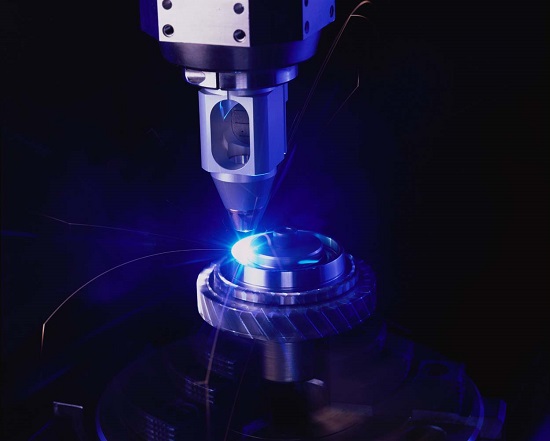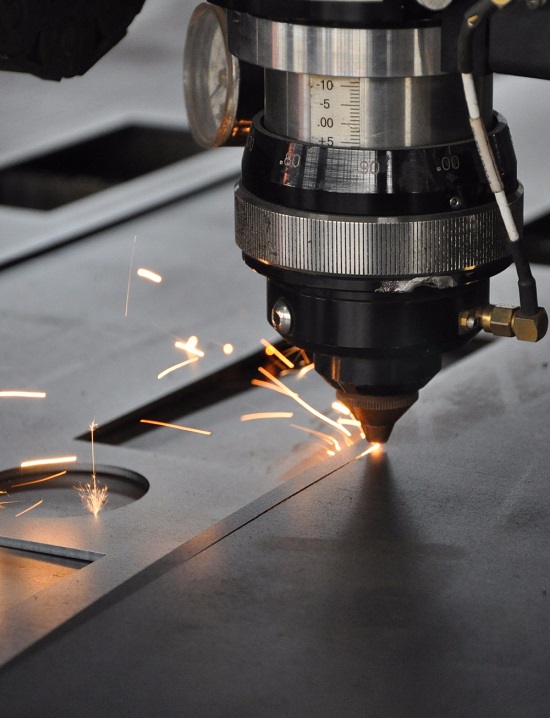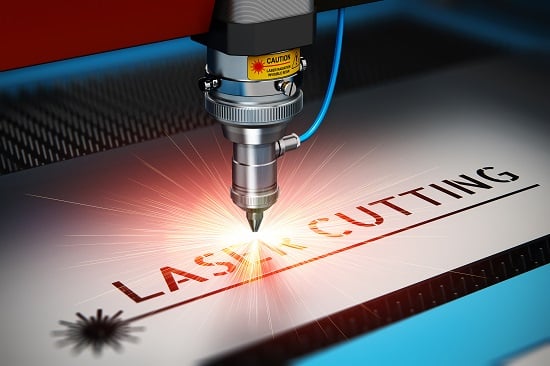Many variants of laser technology are currently used in production processes.
Including cutting, welding, marking, surface engineering and direct parts fabrication.
The range of applications covers metals, plastics, semi-conductors and ceramics, on a scale from sub-micron to several metres.
Many industries, including the automotive, shipbuilding and aerospace sectors, are using laser welding and laser cutting technology.
Deep Penetration Laser Welding
Deep penetration laser welding is a non-contact joining process, characterised by its high-focussed energy density. Which is capable of producing high aspect ratio welds (weld width : weld depth) in many metallic materials.
It can be performed at atmospheric pressure and with a relatively low heat input, compared with inert gas arc welding processes.
Laser Welding Applications.
Deep penetration laser welding is a versatile fusion welding process, which has found wide application in industry.
From spot welding of razor blades to welding of aerospace and marine structures.
The process can be used to weld a variety of materials including, carbon steel, stainless steel, titanium, aluminium, nickel alloys.
The industrial uptake of laser welding is driven by a requirement for high volume production and/or high weld quality.
Laser Welding Process.
The high focusability of laser beams enables power densities in the range 10^3 – 10^7 W/mm^2 to be applied to the joint. These power densities are sufficient to form a ‘keyhole’ (see video) below the laser beam impingement point.
Efficient absorption of the laser beam by this keyhole, allows low heat-input welds to be produced at fast processing speeds. These fast processing speeds, combined with the ease of automation of industrial laser sources, lead to reliable, repeatable, and autonomous high volume production.
Heat inputs are ordinarily an order of magnitude lower than arc welding processes, promoting the adoption of deep penetration laser welding in components requiring minimal thermal distortion.
TWI has considerable experience in the successful development and qualification of deep penetration laser welding procedures. Applying for a variety of different applications, across numerous industry sectors.
Laser Welding Advantages:
• Deep narrow welds
• Low heat input, and consequently minimal thermally induced distortion
• Ease of automation
• Joint design flexibility
• High repeatability
• Joint design flexibility
• Aesthetically pleasing welds
Do you use a flame cutting machine now? If you up-grade to a Laser – remember Westermans International will BUY your surplus machine and pay you over the odds for it.

Hybrid Laser Arc Welding
Another method of laser welding is the hybrid laser-arc welding process.
Combining arc welding and deep penetration laser welding simultaneously in the same weld pool. This method of laser welding combines the individual advantages of both arc welding and laser processes.
These include deep penetration welds of a similar quality to laser welds, with more of a tolerance to joint fit up that is comparable with arc welding.
Greater control over weld quality and properties than autogenous laser welding, is also achieved via the use of arc welding consumables and gases.
In theory, the combination of any arc welding process and laser beam can be used, however the most common variants are laser – TIG and hybrid laser – MIG/MAG.
Hybrid laser welding is being used or considered for use for the below applications and industries:
• Road transport – the high speed and large volumes required in the automotive industry, lends itself perfectly to the capabilities of hybrid laser welding. As well as the part fit-up tolerance being greater when compared with autogenous laser welding.
• Shipbuilding – standard MIG/MAG or SAW processes produce more distortion when welding, in comparison the low distortion of hybrid welding. This reduces the amount and cost with distortion correction and rework.
• Rail transport – again reduced fabrication costs when producing railcars is achieved by low distortion from hybrid laser welding, as with above ship building applications.
• Oil and gas – currently tested and being developed further is hybrid orbital girth welding and longitudinal welding of pipes. This could potentially mean increasing root pass and joint completion rates, depending on the operating environments and pipe steel grades used.
The chief benefits of hybrid laser-arc welding can be summarised as:
• Joint fit-up tolerance improvement over autogenous welding.
• Improved weld quality when compared with laser welding.
• Increase in single pass penetration depth.
• Welding speeds increased.
• Lower distortion rates, due to the heat input being reduced by the increase of welding speed and penetration depth.
Over the past decade, TWI has been carrying out developments of the hybrid welding process on a range of materials, within the Core Research Programme (CRP) and Group Sponsored Projects. As well as for its Industrial Members.
Examples of TWI’s work in hybrid welding include:
• CO2 laser-MAG welding of butt joints between C-Mn steel plates. Including assessments of joint gap bridging ability and weld qualities and properties.
• Nd:YAG laser-MAG welding of T joints between C-Mn steels, and resulting properties. Primarily for shipbuilding applications.
• High speed, low distortion hybrid welding of aluminium alloys using latest generation fibre lasers.
• Low internal porosity content hybrid welding of aerospace aluminium alloys using fibre-delivered lasers.
• Hybrid welding of higher strength stainless steels.
• Real-time process control when hybrid welding butt joints in steels, stainless
steels or aluminium alloys
You can read more about this here.

Laser Cutting
The more popular use for industrial lasers is for cutting, with most applications using two types – CO2 and the more recent fibre laser processes.
The laser beam produced is of such high power, it is used to melt the material in an extremely localised area.
A co-axial gas jet is used to eject the molten material and create a kerf.
Like with other mechanised cutting processes, a CNC control is then used to move the laser head and produce a continuous cut.
There are three major varieties of laser cutting: fusion cutting, flame cutting and remote cutting.
Laser Cutting Process Information.
Laser cutting is a versatile process, which can be used in the cutting of metals and non metals including wood and thermoplastic.
The accuracy and squareness of edges, along with greater heat input control, means it is often favoured for certain applications over other cutting techniques. These include the likes of oxy fuel and plasma. Laser cutting is considered state of the art technology, that comes with a price tag to match!
Benefits of using laser cutting include:
- No surface blemishing – non contact with the workpiece.
- Ideal for small batches due to quick set up times
- Low heat input means a smaller Heat Affected Zone and less distortion.
- High quality cut means no additional finishing processes required.
- Versatile – can be used to cut an array of material and simple or complex parts easily.
- Narrow kerf cuts offer high precision results
The fibre laser process has recently been developed to increase cutting speeds and decrease operating costs.
Fibre laser is also capable of cutting copper, brass and aluminium.
It is also much safer than CO2 laser as the beam is not reflected it is absorbed, however CO2 can offer a better cut finish on thicker material. This means it may be more suitable for industrial fabrication requirements.
Co2 Laser:
- Produced via an electrical discharge through a gas mix of Co2, helium and nitrogen.
- Can cut thicker material (usually greater than 5mm) when compared with a fibre laser of the same power.
- Produces a smoother surface finish when cutting thicker material.
- Mainly use a 3 axis (X,Y and Z) system.
- Most often, the workpiece is not moved, therefore there is no real limit on sheet weight.
- Easier access to the workpiece as it is not an enclosed system.
Fibre Laser:
- Can offer much faster speeds than Co2.
- Heavily reduced power consumption when compared with Co2 laser cutting.
- The fibre laser is much more dangerous than a Co2 laser, therefore it is a fully enclosed system with viewing area, however it is much harder to see what is going on.
- Significantly reduced operating costs due to power and electrical efficiency to produce the laser beam.
Laser Cutter Manufacturers.
Trumpf, Bystronic, Amada, LCD and ESAB are great makes of Laser cutting equipment.
Laser Cutting Support.
TWI has the necessary equipment, knowledge and expertise to perform R&D activities in the field of laser cutting with fibre delivered laser sources. Providing support to its members for all aspects of introducing the process.
From the specification and procurement of laser cutting systems, to the development of cutting procedures by addressing material, optical and gas-jet design issues.
Upgrading from a CNC Plasma cutter?
If you buy a Laser cutter – does that mean you no longer have a need or the space for your CNC plasma cutter? Why not sell your surplus machine to us and we will pay you over the odds for it.
We will arrange inspection/dismantling and collection, giving you a hassle-free sale while getting some cash to put towards your new laser cutter!
Contact us below for more information.



comments
My dad would like to have a customized metal coffee table, which is why he’s currently looking for a laser cutting service that will complete the job. Well, thank you for suggesting here that the hybrid laser arc welding include deep penetration as well. It’s also a good thing that this will provide a faster result.
It’s interesting to know that laser technology can now be used on automatic girth welding. I think I’ll get one from a good supplier since I’m sure that we’ll be able to use hybrid laser arc welding techniques for it. Since we’re in the gas industry, the pipes grades that we’ll use will definitely be compatible with our project.
One of the major benefits of laser welding is that it offers a high level of accuracy and control. Capable of handling complicated joins, uses low heat application, minimizes the distortion of the components, used to make strength welds.
Well described post. Thanks for sharing this useful information.
Laser welding systems are superior than conventional process for making laser welding equipment with respect to its quality, speed, and economy.